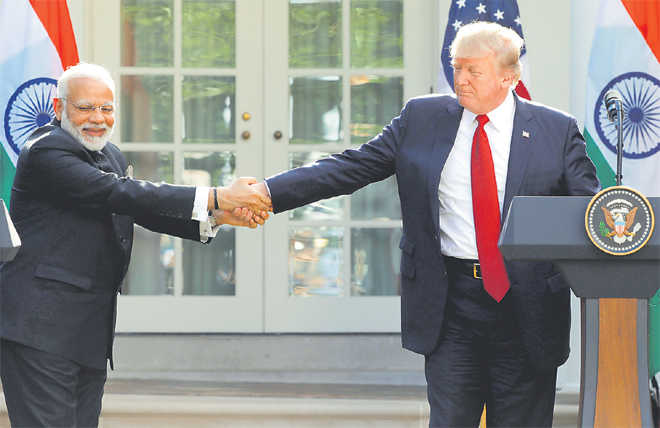
REACHING OUT: Donald Trump greets Narendra Modi during their joint news conference in Rose Garden at the White House in Washington, US, on June 26. Reuters
Sandeep Dikshit
Prime Minister Narendra Modi’s three top-level interactions in Washington would have provided a fair understanding of India’s position in Donald Trump’s scheme of rearranging international relations in Asia.
Trump is forthright, some would say non-statesmanlike, in conducting state business, making it easier for the side at the other end of the negotiating table to understand the underlying motives and expectations. His chief consiglieres, the ministers for Defence and Foreign Affairs, have a similarly unvarnished approach of laying out their cards.
These three policy-marker meetings have made it clear that the White House retains the Obama era policy of encouraging India to concentrate on its eastern approach. This means American help for building trade bridges with the four US allies — ASEAN, Australia, South Korea and Japan — as well as in positioning India as a neutraliser of China’s increasing maritime presence. The Trump era disinterest in the US “Pivot to Asia” does not yet translate into India losing its usefulness as a major naval force in the Indo-Pacific. With Japan and Australia also stepping up their maritime presence, the US Deep State believes this quadrilateral should be kept in readiness as a formidable armada off China’s southern and eastern coasts.
The Indo-Pacific Economic Corridor that would cut a road link across Bangladesh/Myanmar, Thailand and Vietnam not just reopens a route for India that has remained closed ever since the Europeans initiated hostilities with the Japanese, it also fits in with the American plan to checkmate transport corridors descending from China into these countries. This battle of corridors – west-east (India to Vietnam) pitted against China’s north-south (Myanmar, Bangladesh and Thailand) – and the contest of the seas will ensure India remains embedded in American economic-military strategy despite waxing and waning of this concept’s importance among successive White House Administrations. This realisation explains India’s alignment with the US position on the North Korean missile tests. It also pleases South Korea, emerging as a prominent supplier of defence equipment.
But on the west, especially in Pakistan and Afghanistan, India has to strike alliances on its own. The MEA spokesperson’s choice of phraseology after the PM met US Secretary of Defence John Mattis indicated that the CIA/Pentagon would prefer to do business in Afghanistan without the India-Pakistan zero-sum contest. Another reason for US opposition to a dust-up is it plans to push a gas pipeline from Turkmenistan to permanently kill any prospects of Iranian gas finding a market in the region. This US disinclination to hostilities brought about a softened Modi. He did touch upon the surgical strikes during a town hall with the Indian diaspora, but unlike at the previous G-20 and SCO summits, there was no laundering of neighbourhood animosities from the pulpit. Instead, the PM spoke of a peaceful neighbourhood and the sharing of India’s growth spoils with the world.
India earned two endorsements of its position on regional security. The Trump-Modi joint statement threw Pakistan down the stairs for fostering violent militant groups. It was burnished with the US naming a Pakistan based Kashmiri militant leader as a global terrorist. But too much is being read into the joint statement’s suspicions about the OBOR. The businessman in Trump would have to balance the multi-billion dollar contracts being won by American companies with the US military-intelligence establishment’s suspicions of the strategic game plan wrapped in China’s OBOR trade-only claims. Clearly opportunities from the $ 1 trillion OBOR infrastructure development pie do not put US opposition on the same footing as that of India, which is also suffering the anxiety of encirclement.
Trump has suggested in no uncertain terms that the US needs more Indian business to get it more interested in Indian strategic priorities. With a $ 500 billion trade deficit, Trump is looking at Indian efforts to reduce its trade surplus with America. These mean creating the right tariff environment for its capital goods and opening up the Indian market for American IT and agricultural products. It also means killing all Indian expectations of a liberal visa regime and if possible handing Westinghouse with a $ 50 billion contract for six nuclear reactors. Trump also explained that India was not getting access to sensitive and closely held technology because its intellectual property regime does not measure up to Pentagon’s expectations.
Without this to-do list, India’s aspiration to ride on American technology to sharpen its military edge and backing to enter NSG may have to remain on hold. The US has given that indication by slowing down work on an ambitious military co-production project of building an aircraft carrier. The official explanation could not be weaker: the US Navy team earmarked for the project is busy de-commissioning USS Enterprise. The implication is India’s attempt to reach aircraft carrier parity with China gets delayed.
On the eve of his departure to the US, PM Modi had signalled India’s willingness to qualitatively improve its surveillance of the Indian Ocean – which primarily means keeping an eye on Chinese vessels – with products bought from American companies. His $ 2 billion order pales in comparison to Qatar’s $ 13 billion and Saudi Arabia’s $ 110 contracts for US military equipment. Clearly, Indian foreign policy will have to keep its multi-vector approach alive. It will be too expensive to have Trump as the sole ally.



























